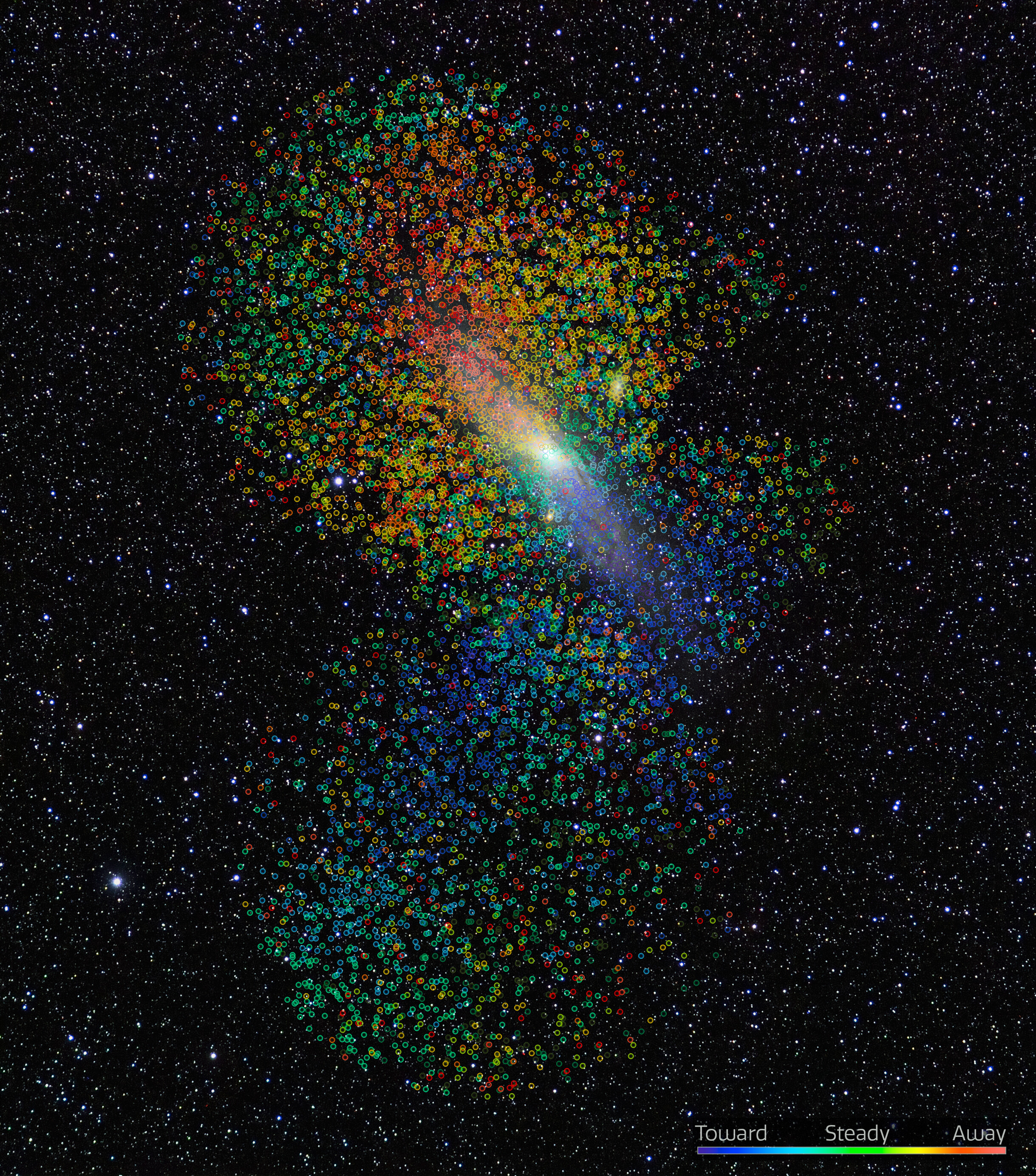Andromeda galaxy crash triggered a mass galactic migration 2 billion years ago
The influx of stars into the galaxy next door to the Milky Way was revealed by intricate patterns in their motion today and reflects a violent event in our galaxy’s past.
Astronomers have discovered new evidence that Andromeda, the galaxy next door to our own, grew by merging with another galaxy. The event triggered a mass migration of stars into the galaxy.
This event suggests that the migration of stars to Andromeda and the galaxy's growth history is very similar to that of the Milky Way. That means the findings have implications for our understanding of both galaxies.
The evidence came in the form of observations of the individual motions of almost 7,500 stars in the inner halo of Andromeda. This showed these stars had begun their lives as part of another galaxy that merged with Andromeda around 2 billion years ago.
Related: The Andromeda Galaxy (M31): Location, Characteristics & Images
Scientists have long predicted that large galaxies like the Milky Way and Andromeda have grown to their current sizes via collisions and mergers throughout their history, but the patterns in the motions of stars that could confirm this have been elusive.
The investigation was conducted by an international team of astronomers using Dark Energy Spectroscopic Instrument (DESI) on the Nicholas U. Mayall 4-meter Telescope at Kitt Peak National Observatory, operated by NOIRLab.
"Our new observations of the Milky Way's nearest large galactic neighbor, the Andromeda Galaxy, reveal evidence of a galactic immigration event in exquisite detail," lead researcher and NOIRLab astronomer Arjun Dey, said in a statement. "Although the night sky may seem unchanging, the universe is a dynamic place. Galaxies like M31 and our Milky Way are constructed from the building blocks of many smaller galaxies over cosmic history. "
Breaking space news, the latest updates on rocket launches, skywatching events and more!
The majority of the stars in the Milky Way's halo are also believed to have originated in another galaxy finding a new galactic home during a massive merger event thought to have occurred between 8 to 10 billion years ago. Looking at relics of a previous merger and stellar migration event in Andromeda could help astronomers hunt for similar artifacts in our own galaxy.
"We have never before seen this so clearly in the motions of stars, nor had we seen some of the structures that result from this merger," researcher co-author and University of Edinburgh astrophysicist, Sergey Koposov, said in the statement. "Our emerging picture is that the history of the Andromeda Galaxy is similar to that of our own galaxy, the Milky Way. The inner halos of both galaxies are dominated by a single immigration event."
To trace stellar migration in the galaxy, the team turned to DESI due to the fact that it is the most powerful multi-object survey spectrograph in the world, capable of measuring the spectra of more than 100,000 galaxies in a single night.
"This science could not have been done at any other facility in the world. DESI's amazing efficiency, throughput, and field of view make it the best system in the world to carry out a survey of the stars in the Andromeda Galaxy," Dey added. "In only a few hours of observing time, DESI was able to surpass more than a decade of spectroscopy with much larger telescopes."
Despite first opening its eye to the universe in 1973, the Mayall Telescope is still able to play a role in cutting-edge research like this thanks to five decades of upgrades and improvements.
The team will now continue to use the team-up between DESI and the Mayall Telescope to investigate stars located closer to the edge of Andromeda. They hope this will further reveal the galaxy's structure and the immigration history of its stars.
"It's amazing that we can look out at the sky and read billions of years of another galaxy's history as written in the motions of its stars — each star tells part of the story," team member and NOIRLab researcher Joan R. Najita said. "Our initial observations exceeded our wildest expectations and we are now hoping to conduct a survey of the entire M31 halo with DESI. Who knows what new discoveries await!"
The team's research is published in The Astrophysical Journal.
Follow us on Twitter @Spacedotcom or on Facebook.

Robert Lea is a science journalist in the U.K. whose articles have been published in Physics World, New Scientist, Astronomy Magazine, All About Space, Newsweek and ZME Science. He also writes about science communication for Elsevier and the European Journal of Physics. Rob holds a bachelor of science degree in physics and astronomy from the U.K.’s Open University. Follow him on Twitter @sciencef1rst.

